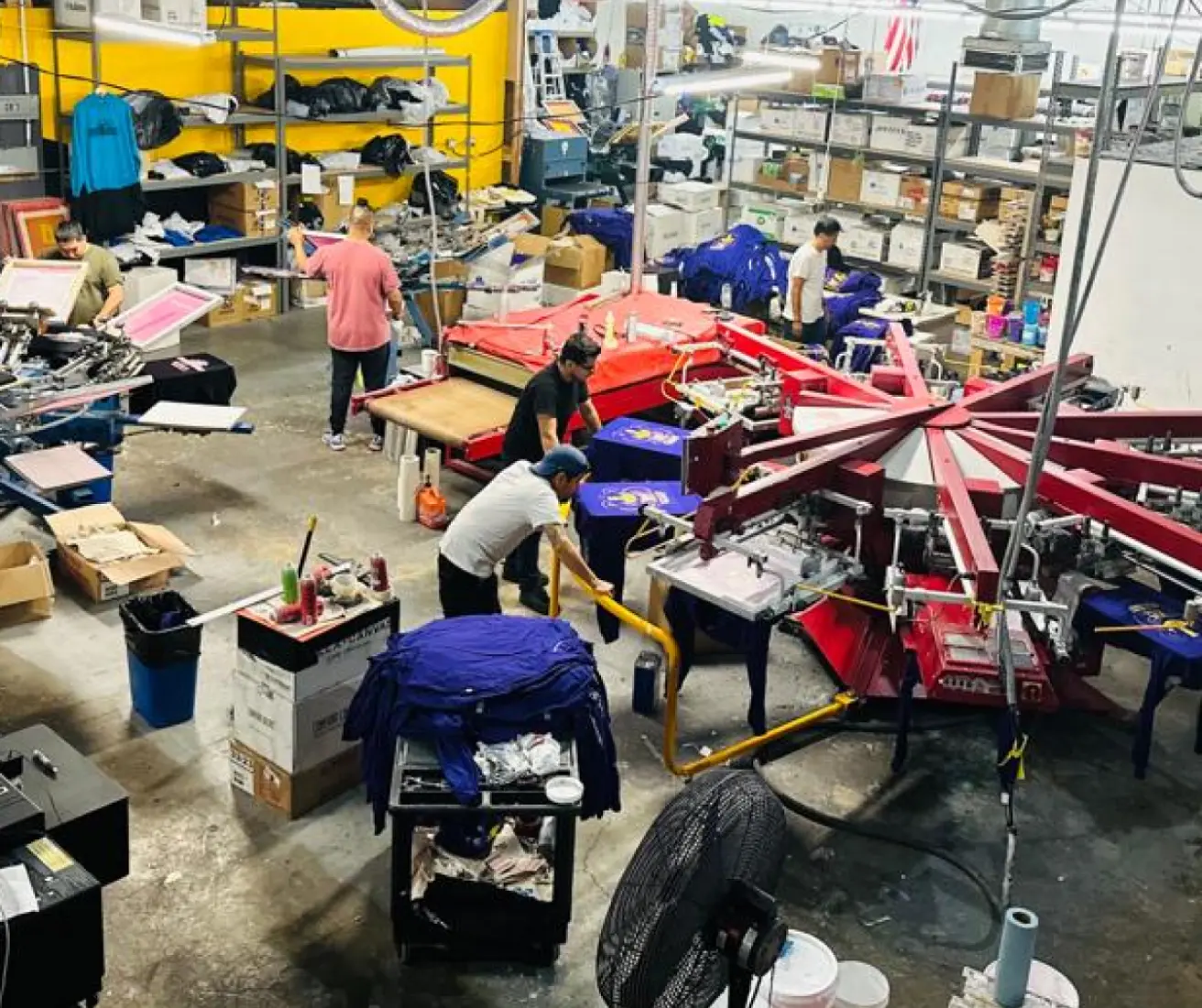Beginner-Friendly Screen Printing Kit for DIY Projects
Beginner-Friendly Screen Printing Kit for DIY Projects
Blog Article
Screen Printing Uncovered: Every Little Thing You Need to Learn About T-Shirt and Garment Printing Strategies
Display printing is a fascinating technique that integrates art with method, offering limitless possibilities for creative thinking. Ready to discover the vital elements that make screen publishing an art form?
The Fundamentals of Display Printing: Just How It Functions
When you dive into screen printing, you'll find it's both a scientific research and an art. At its core, display printing includes creating a pattern, or display, that allows ink to go through only in details locations (screen printing kit). You begin by selecting your style and preparing your screen with a light-sensitive solution. As soon as you reveal this emulsion to light, it hardens, leaving your style as an unfavorable space.
Following, you'll mix your inks and prepare your printing surface area. Setting the display over the material, after that use a squeegee to push ink with the display onto the garment. This procedure requires precision, as you want clear, lively prints. After printing, you'll heal the ink with heat, ensuring it follows the textile and lasts with washes. Each action is important, and grasping them will certainly boost your display printing abilities, transforming straightforward garments into one-of-a-kind, expressive items.
Sorts Of Screen Printing Methods
As soon as you understand the essentials of display printing, it's time to discover the different methods that can elevate your layouts. One preferred approach is typical display printing, where ink is pressed through a stenciled display. This method is excellent for vibrant, lively shades. There's water-based ink printing, which uses a softer feel and is environment-friendly, but it needs a various strategy to treating.
One more option is plastisol printing, known for its durability and vivid shades, making it a preferred for several brands. Experiment with halftone printing to produce gradient impacts and complex layouts.
Vital Devices for Display Printing
To achieve sensational results in display printing, having the right devices is fundamental. You'll require a durable screen printing structure, which holds the mesh that transfers your layout onto the garment. Next, invest in top quality mops; these are vital for applying ink evenly throughout the display.
Choosing the Right Inks and Materials
When picking inks and products for display printing, you need to think about the sort of ink that works best for your task. Think concerning fabric compatibility to ensure your layouts look terrific and last lengthy. Explore environment-friendly ink options to make your printing procedure much more sustainable.
Sorts Of Display Inks
Selecting the best screen ink is crucial for attaining dynamic, sturdy prints that fulfill your task's needs. There are several kinds of display inks to take a look at. Specialized inks, such as glow-in-the-dark or metallic, can add unique impacts to your designs.

Fabric Compatibility Factors To Consider
Comprehending fabric compatibility is vital for achieving top notch screen prints, specifically because various materials respond uniquely to numerous inks. Constantly evaluate your inks on sample material to assure they stick effectively and preserve shade honesty. Additionally, maintain in mind that textile weight and structure can influence the final end result, so picking the ideal ink and product combination is important for your project's success.
Eco-Friendly Ink Options
Environment-friendly inks are coming to be a preferred option for display printers who wish to minimize their environmental effect while keeping quality. When choosing inks, take into consideration water-based inks, which are less unsafe and simpler to cleanse up contrasted to conventional solvents. These inks bond well with fabrics, providing vivid results without hazardous chemicals. You could likewise discover eco-solvent inks that utilize less unstable organic substances (VOCs), making them a much safer alternative for both your health and wellness and the earth.
Additionally, search for inks made from renewable resources, such as soy or vegetable-based options. By picking the best inks and materials, you'll not just produce sensational styles however likewise add to a more sustainable printing process. Make the button, and your prints will certainly show your commitment to the setting!
Preparing Your Layout for Display Printing

Submit Layout Needs
To guarantee your layout looks dynamic and sharp on textile, you'll need to pay close focus to file layout requirements for display printing. Make sure your layout has a transparent history to protect against undesirable white edges on your prints. Maintain color settings in mind; CMYK is basic for screen printing, so convert your RGB creates appropriately.
Color Splitting Up Techniques
Shade splitting up is an important step in preparing your style for display printing, and grasping it can significantly boost your print quality. You'll require to damage your layout into individual shades, as each color needs a different display throughout printing. This precision not just assures exact shade depiction however additionally streamlines the printing process.
Resolution and Dimension
Achieving the most effective outcomes in display printing begins with ensuring your style has the best resolution and dimension. Ideally, your artwork should be at least 300 DPI (dots per inch) for sharp, clear prints. If you utilize lower resolution, your end product could look less than professional and pixelated.
When it concerns dimension, consider the measurements of your print location. Layout your art work to match the final print size, ideally developing it in the real measurements you'll be printing. This way, you'll stay clear of any unanticipated scaling concerns.
Always inspect your layout in both vector and raster styles. Vector graphics can be scaled without losing top quality, making them ideal for display printing. Preparing properly will guarantee your design looks outstanding on every garment!
Step-by-Step Screen Printing Refine
Display printing is a dynamic process that permits you to develop dynamic designs on different surface areas. To start, you'll need a display, solution, and your selected ink. Initially, prepare your screen by cleaning it thoroughly. Next, use the emulsion equally and let it completely dry in a dark location. Once completely dry, expose your display to light with your layout positioned on it, which will certainly solidify the solution where the light hits, producing a stencil - screen printing kit.
Pour ink onto the display and make use of a squeegee to press the ink via the stencil onto the material. Lift the display very carefully and allow the print completely dry. You have actually effectively screen printed your style.
Tips for Effective Display Printing Projects
While you're diving right into your screen printing projects, keep in mind that preparation is vital to success. Start by collecting all your products-- inks, displays, mops, and garments. A tidy work space assists protect against unwanted mistakes, so clean up before you begin.
Next, confirm your art work is high-resolution and correctly sized for your garment. Test your screen for correct exposure and clean it thoroughly to avoid smudges. When mixing your inks, follow the producer's guidelines to achieve the best uniformity.
Throughout printing, apply also pressure with your squeegee for constant outcomes. Don't rush; take your time to validate each print satisfies your requirements. After printing, let your garments dry entirely prior to dealing with or packaging them.
Lastly, always maintain an example of your benefit future reference. This means, you can examine your progression and boost your strategies in time. Happy printing!
Often Asked Inquiries
For how long Does It Take to Establish a Screen Printing Job?
Establishing a display printing job normally takes about 30 minutes to an hour. You'll prepare the displays, mix inks, and adjust journalism. The moment varies based upon complexity and experience, so stay arranged!
Can I Publish on Various Textile Keys In Using the Exact Same Method?
Yes, you can print on different fabric types utilizing the very same technique, yet you'll need to adjust your inks and setups. Some fabrics absorb ink differently, so exploring assurances the most effective results for every material.
What Are Typical Errors to Avoid in Display Printing?
When display printing, prevent typical mistakes like making use of the incorrect ink, overlooking appropriate exposure times, or avoiding pre-press checks. Always evaluate your arrangement and keep clean screens to guarantee top quality results each time.
How Can I Appropriately Clean and Maintain My Screen Printing Devices?
To effectively clean and maintain your screen printing devices, you should routinely clean screens with proper solvents, check mops for wear, and guarantee all devices are kept completely dry and dust-free. Uniformity avoids costly repairs and boosts efficiency.
Is Screen Printing Eco-friendly Contrasted to Other Techniques?
Screen printing can be a lot more eco-friendly than various other approaches, especially if you use water-based inks and eco-conscious materials. By choosing lasting materials and practices, you reduce waste and decrease your influence on the earth.
Display Printing Uncovered: Every Little Thing You Required to Know Regarding T-Shirt and Garment Printing Techniques
At its core, display printing entails developing a pattern, or display, that permits ink to pass through only in certain locations. Position the screen over the fabric, after that make use of a squeegee to push ink through the display onto the garment. One preferred technique is conventional screen printing, where ink is pressed with a stenciled screen.When selecting inks and materials for screen printing, you need to take into account the type of ink that works best for your job.
Report this page